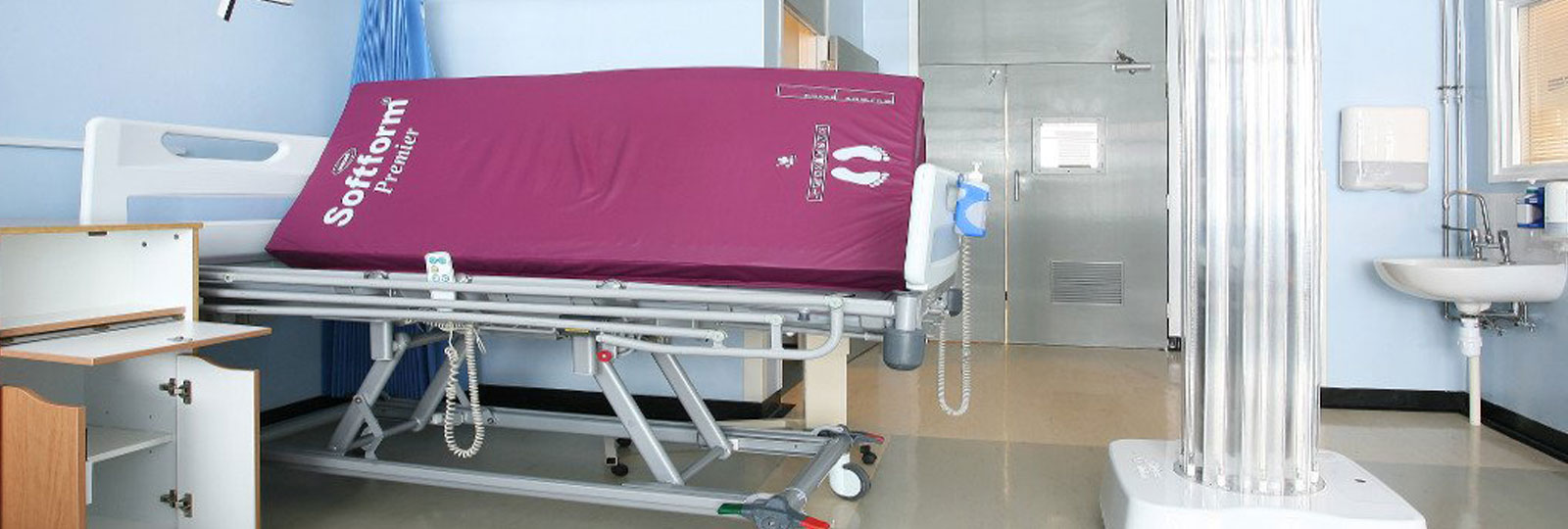
Decontamination is a series of processes that effectively remove or destroy infectious agents or other contaminants (e.g. organic matter) in order to prevent the spread of infection.
Specialist automated technologies, including ultraviolet (UV-C) light and hydrogen peroxide vapour (HPV), can play an important role in the efficacy of cleaning practices and controlling the spread of infection.
But choosing the most appropriate automated decontamination system can prove to be a challenging decision. One of the biggest issues is that these technologies are often widely misunderstood at an operational level, particularly amongst hospital cleaning and facilities staff who can be cautious of it due to concerns over safety.
So what’s the difference between UV-C and HPV? How do they work? And which should you choose for your ward?
How does ultraviolet (UV-C) light work?
Ultraviolet (UV-C) light can kill or inactivate microorganisms. Used as part of a disinfection method known as Ultraviolet germicidal irradiation (UVGI), it destroys nucleic acids and disrupts their DNA, leaving them unable to perform vital cellular functions.
Regular usage of UV-C decontamination systems, such as Ultra-VTM and Ultra-V ConnectTM, has been shown to create a safer patient environment, to contribute to optimised bed flow and to improve the overall patient experience.
How does hydrogen peroxide vapour (HPV) work?
Hydrogen peroxide is a liquid chemical compound that is made up of hydrogen and oxygen atoms, that naturally decompose into water and oxygen. It is a powerful oxidising agent that kills bacteria easily. This makes HPV decontamination an effective method for sterilising and disinfecting surfaces contaminated with microorganisms such as MRSA and C.difficile.
HPV involves the release of microscopic droplets of hydrogen peroxide which are able to spread in an enclosed area, such as a lab. ProXcideTM, for example, delivers vaporised hydrogen peroxide using a unique method of vapour dispersal technology combined with powerful circulation.
How safe are they?
Both UV-C and HPV decontamination systems are residue-free and safe to use.
The UV-C decontamination system Ultra-V, for example, enables remote control operation of the main unit from outside the treatment area. This eliminates the risk of operator exposure to UV-C light.
Although hydrogen peroxide can potentially be hazardous to humans, HPV decontamination systems are completely safe to use. The HPV decontamination system ProXcide, for example, uses a vapour called Proxin, which has a low concentration of hydrogen peroxide, making it suitable and safe for the hospital environment and patient equipment. Plus, no operator programming is required. The system automatically adjusts every decontamination process for the specific environment, and hydrogen peroxide is automatically and rapidly deactivated at the end of the process.
Of course, as with any equipment, operators will need clear instructions on how to use them and receive appropriate training.
Which is best?
UV-C decontamination tends to be relatively inexpensive and quick, so it’s not surprising that it tends to be more widely used than HPV. It has also been around for longer, having been used for disinfection purposes in hospitals since the mid-20th century. Due to it’s quick decontamination time it is commonly used in ICU, ED and MAU wards in hospitals. Ultra-V, for example, can reduce pathogens within 15-30 minutes, depending on the size of the room.
If your ward is experiencing an extremely high volume of patients and there is little time to perform effective cleaning, a UV-C system can be very effective.
However, UV-C systems are less effective for areas that are out of the direct line of sight. It can’t sterilise any area of a surface that is blocked or covered by other objects. UV-C is also not as effective at dealing with more robust bacterial spores.
HPV is arguably the more effective form of decontamination. If your ward has very high rates of HAIs, a HPV system could be more useful. It takes longer (ProXcide provides decontamination in under 2 hours) but will ultimately create a safer environment for patients. HPV is proven to be very effective in tackling spore-forming organisms, such as C.difficile.
One final consideration is that rooms must be sufficiently prepared before beginning a decontamination cycle with HPV. This means removing any absorbent materials, separating adjacent surfaces and sealing off any ventilation and potential leak points.
Summary
UV-C and HPV are both effective methods to reduce the risk of hospital-acquired infections (HAIs). Whichever method you choose, it’s important that staff are given appropriate training to ensure they can use the devices with confidence and achieve the best results.
Neither UV-C or HPV decontamination systems are intended to replace manual cleaning, but rather should be used as a complementary method to create a safer environment.
At Inivos, we have created UV-C and HPV products specifically for healthcare, taking into account the need for high efficacy, rapid turnaround and safe processes. To discover our full range of products, click here.





